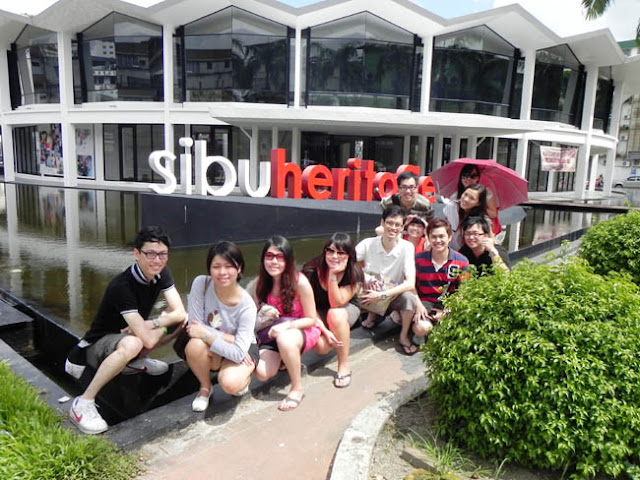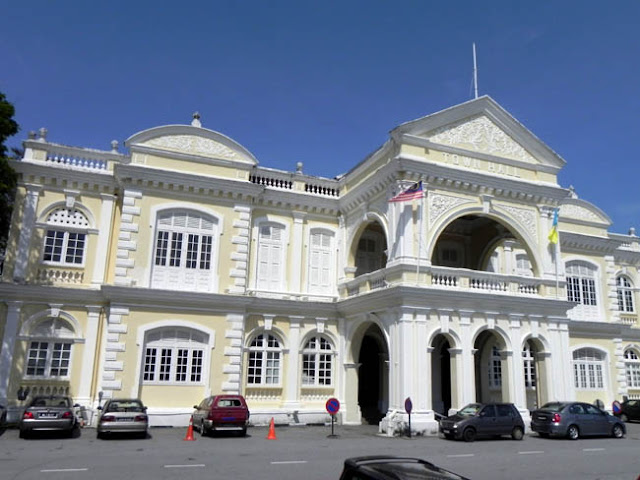Thanks to my brother's wedding, we received a band of Perakians in Sibu. They are young, energetic, full of curiosity, adventurous and, that's their first time in Sibu. The town by the River of Goose had plenty to offer. As their tour guide, I had to reveal the hidden gems of Sibu to them.
Sunday, mid of December, 9 am, clear blue sky with merciless blazing sun. We started our journey from Kingwood Hotel to scout for renown dian-bian-hu (鼎边糊) at Sibu Butterfly Garden. Along the way, the story of why the Rejang River is crowned with another name- the River of Swan was told. We stopped at Sibu Express Boat Terminal for a while to visualize the importance of the river to the people in Sarawak.
My original plan- visit Yong-An Ting and the pagoda first before breakfast. But they were really starved. So plan B- the food first.
How good was the dian bian hu? You can tell from their expression. I had to order the food for three rounds to feed their appetite. By the way, they were sitting in Ah Hee Kopi Tian, while ordering dian bian hu from the food stall beside the coffee shop. They tried char mian (fried noodle) and char meehun (fried beehun) as well at the coffee shop.
This is a bowl of the traditional Foochow delight with cuttlefish, home made fish ball, black fungus, blended with Sarawak black pepper. Beware, it is highly addictive!
After the breakfast, they stormed the souvenir shop beside the coffee shop.
Out of a sudden, three samurai appeared in front of Alih Craft (the souvenir shop) ...
Knowing the place of worship is always nearer to heaven, some of them had actually tried to fly right into the heaven...
They did it... for a short while.
Then, I brought them to Sibu Heritage Centre at Central Road. This building used to be the head office of Sibu Municipal Council. We spent nearly one hour in the centre.
Security.... someone is taking photo inside the exhibition hall!!
12:30 pm, we left the heritage centre to find something to eat (what, eat? Again?).
So I brought them to this very old gom bian shop, Seng Kee at Market Road.
And all of them really "give-face" by eating the gom bian right in front of the shop. Btw, I think the shop owner should give some advertising fee to these ladies to stand a bit longer in front of the shop.
Next stop, Sibu Central Market. I showed them the hand made soo-mee (a special type of local handmade noodle), dried kampua mee (another type of noodle), and some indigenous fruits and vegetables.
This is how the dried kampua mee looks like.
They were lucky. One of the seasonal fruits- Dabai was found in the market. Besides, they found buah Sibau, ikan masin terumbok (Sarawak famous salted fish), and paku (a kind of edible fern). Driven by the tiredness, I couldn't show them many other things, such as tebaloi, the mountain durian, buah terap, sago, mulung, and fresh midin.
Sibu Central Market guarantees no empty hands!
Our tour officially ended at 2 pm, after I successfully brought them back to the hotel. I didn't bring them to Wisma Sanyan, Sibu Town Square and Masland Church at Island Road as all my tour members had visited the places a day before.
A solid five hours tour ended with one conclusion- Sibu is not as small as we thought. Summary of the places that we visited- Rejang Esplanade, Sibu Express Boat Terminal, dian bian hu for breakfast, souvenir shop, Yong An Ting and the pagoda, Sibu Heritage Centre, traditional gom bian for refreshment, and Sibu Central Market.
Finally, I wish to express my deepest gratitude to all my tour members- Trass, Vernie, Yi Mei, Yong, Jessie, Tong Yuen, Jiunn Wai, Ken, Kun, Lih Yik, Pook, Kit Ling, and Xing Jiun, for the opportunity and the experience as a tour guide, especially for the tour on my beloved hometown.
Regards, Ling Shing.
More about our sharing on Sarawak are available at:
A solid five hours tour ended with one conclusion- Sibu is not as small as we thought. Summary of the places that we visited- Rejang Esplanade, Sibu Express Boat Terminal, dian bian hu for breakfast, souvenir shop, Yong An Ting and the pagoda, Sibu Heritage Centre, traditional gom bian for refreshment, and Sibu Central Market.
Finally, I wish to express my deepest gratitude to all my tour members- Trass, Vernie, Yi Mei, Yong, Jessie, Tong Yuen, Jiunn Wai, Ken, Kun, Lih Yik, Pook, Kit Ling, and Xing Jiun, for the opportunity and the experience as a tour guide, especially for the tour on my beloved hometown.
Regards, Ling Shing.
More about our sharing on Sarawak are available at:





















































